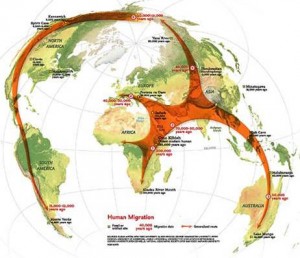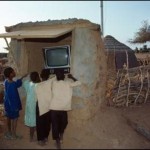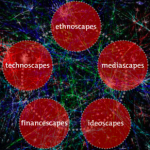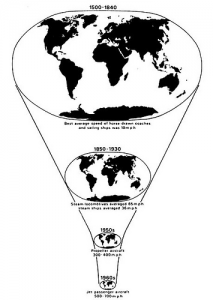Lesson Objectives:
- define globalization
- recognize the interrelationship between global and local processes
- identify how globalization drives cultural change
- situate a selected community within its socio-historical context
While scholars and academics have yet to agree on a precise definition for the term globalization, most agree that the term refers to ever-increasing contact between people throughout the world (Held et al 2005). People often use the term ‘globalization’ when they refer to the global economic restructuring addressed in the preceding section. Although the global economy is undoubtedly a product of globalization, the phenomenon also encompasses social, cultural, ideological and biological exchanges as well. These world-wide exchanges are made possible by what David Harvey refers to as time-space compression.
Time-Space Compression
In his book, The Condition of Post-Modernity (1995), Harvey explains that time-space compression is the result of technological advances in communication and transportation technologies that accelerate the rate of exchange between people across vast distances. What this means is that through technology, the amount of time it takes for people to interact across the same distance is decreased, or compressed. Faster exchange times leads to a greater amount of social interconnectedness. Greater interconnectedness accelerates the rate of cultural change because culture is dynamic; culture changes as people adapt to new circumstances.
Interaction & Exchange
 Although globalization is oftentimes characterized as a 21st century phenomenon, many scholars argue that globalization began when humans initiated the first migration out of Africa more than 50,000 years ago. As people began to colonize different environments throughout the world, they developed new adaptive cultural forms which they shared with neighbors, who shared with their neighbors, and so on. In his book, Europe and the People without History (1995), Eric Wolf shows how technologies and ideas were shared throughout the early trade routes that connected civilizations and cultures long before European colonialism came to dominate the world system. As people moved and interacted along trading routes connecting Africa, Europe, Asia and the Americas, they not only carried and exchanged goods and services, they also engaged in social, cultural, ideological and biological (reproduction and/or communicable diseases) exchanges.
Although globalization is oftentimes characterized as a 21st century phenomenon, many scholars argue that globalization began when humans initiated the first migration out of Africa more than 50,000 years ago. As people began to colonize different environments throughout the world, they developed new adaptive cultural forms which they shared with neighbors, who shared with their neighbors, and so on. In his book, Europe and the People without History (1995), Eric Wolf shows how technologies and ideas were shared throughout the early trade routes that connected civilizations and cultures long before European colonialism came to dominate the world system. As people moved and interacted along trading routes connecting Africa, Europe, Asia and the Americas, they not only carried and exchanged goods and services, they also engaged in social, cultural, ideological and biological (reproduction and/or communicable diseases) exchanges.
The Network Society
 Today, digital technologies have revolutionized world-wide social relations and led to the creation of a global village. In his three-part work, The Rise of the Network Society (2005), Manuel Castells outlines how key social structures and institutions in the 21st century are becoming organized around electronically processed information networks such as internet and cellular communication. These networks have substantially modified, and even undermined, existing networks for production, experience, power, and culture. (The social significance of networks is dramatically portrayed in this Ericsson commercial .) The power of networks was demonstrated by the use of social media, such as Facebook and Twitter, during the Arab Spring uprising by protestors who were able to connect with and garner support from a global audience, and through the ever-increasing popularity of online dating networks which are rapidly becoming the primary platform for romantic and sexual encounters between individuals across vast distances. Another example is the ways that exchange and barter systems that distribute tangible money resources have given way to digital financing and banking systems that are built on the exchange of intangible monetary wealth. Advances in communication and transportation networks has dramatically altered the way people interact with one another and transformed social relationships. Networks have touched virtually every aspect of social relations, as even people living in the most remote and rural areas of the world are linked into the network via satellite television networks and internet communications.
Today, digital technologies have revolutionized world-wide social relations and led to the creation of a global village. In his three-part work, The Rise of the Network Society (2005), Manuel Castells outlines how key social structures and institutions in the 21st century are becoming organized around electronically processed information networks such as internet and cellular communication. These networks have substantially modified, and even undermined, existing networks for production, experience, power, and culture. (The social significance of networks is dramatically portrayed in this Ericsson commercial .) The power of networks was demonstrated by the use of social media, such as Facebook and Twitter, during the Arab Spring uprising by protestors who were able to connect with and garner support from a global audience, and through the ever-increasing popularity of online dating networks which are rapidly becoming the primary platform for romantic and sexual encounters between individuals across vast distances. Another example is the ways that exchange and barter systems that distribute tangible money resources have given way to digital financing and banking systems that are built on the exchange of intangible monetary wealth. Advances in communication and transportation networks has dramatically altered the way people interact with one another and transformed social relationships. Networks have touched virtually every aspect of social relations, as even people living in the most remote and rural areas of the world are linked into the network via satellite television networks and internet communications.
Globalization & Power
Globalized exchanges are embedded in systems of power and inequality at the local level to the global arena. In the Households and Families section in the next module, we will explore the ways that inequality inside the household can lead to unequal access to resources for certain people in the household, this includes access to communication and transportation resources. The same can be said in rural versus urban areas, or among people of different racial, ethnic, religious or national affiliations. In addition, a country’s political and economic conditions can affect citizens’ access to technology. Because of this, globalization happens unevenly and uneven globalization leads to social fracturing and even conflict.
Disjuncture & Difference
Globalization has frequently been described as a homogenizing phenomenon, a process where everyone is becoming the same. New research is showing how uneven globalization is actually contributing to the proliferation of difference among people living in the same community, even within the same household.
 In his article, ‘Disjuncture and Difference’, Arjun Appadurai characterizes globalization as a system of articulations, or interactions, between global flows and local circumstances. He categorizes global flows as ‘-scapes’ organized into technoscapes (technology), finanscapes (wealth), ethnoscapes (culture), mediascapes (media), and ideascapes (ideology). These scapes are intertwined and interrelated, but they each flow across global networks in distinct and uneven ways. As the global flows come into contact with local circumstances, they articulate and generate new forms. Since local circumstances vary widely throughout the world, each articulation contributes to a more heterogeneous cultural landscape. Today, many scholars are using the term glocal or glocalization to refer to the outcome of global and local interactions.
In his article, ‘Disjuncture and Difference’, Arjun Appadurai characterizes globalization as a system of articulations, or interactions, between global flows and local circumstances. He categorizes global flows as ‘-scapes’ organized into technoscapes (technology), finanscapes (wealth), ethnoscapes (culture), mediascapes (media), and ideascapes (ideology). These scapes are intertwined and interrelated, but they each flow across global networks in distinct and uneven ways. As the global flows come into contact with local circumstances, they articulate and generate new forms. Since local circumstances vary widely throughout the world, each articulation contributes to a more heterogeneous cultural landscape. Today, many scholars are using the term glocal or glocalization to refer to the outcome of global and local interactions.
Coffee, for example, comes from the Arabic word, Kahua, and the beverage was widely consumed in the Middle East and North East Africa for many centuries. During European expansion and colonialism in the 15th century, coffee plants were distributed to the America’s and the cultural practice of drinking coffee spread throughout the world. Yet, the beverage changed into a new cultural form, or glocalized, as it was consumed by different people in different areas. Today, there are a wide variety of coffee manifestations; café au lait, mocha, latte, espresso, cappuccino, etc. It is ironic that one of the most widely consumed cultural forms of coffee emerged from the global articulation with local circumstances in Seattle at Starbucks, several thousand miles away from its origins. And as Starbucks coffee flows through the global networks forged by the transnational corporation, it also articulates with localized circumstances and creates a new form –such as this Starbucks coffee shop in Yemen.
- Coffee or Arabic القهوة
- Starbucks coffee in Yemen
The same can be said for the globalization of musical culture. Many students in the United States are familiar with Step dancing which became popularized by African-American students at colleges and universities throughout the United States, as depicted in the feature film Stomp the Yard.
The origins of Step is rooted in the Welly Gumboot Dance in South Africa. During the colonial period, European controllers of the mining industry forbid African workers from engaging dancing and drumming activities. In response, African miners used their bodies, and their British ‘Welly’ rubber boots, as percussion instruments and created a new cultural form of music and dance which then flowed to the United States and emerged as a different cultural form under new circumstances. Consider the different flows and local articulations that informed the development of each dance: political colonialism, industrial mining, inequality, and rubber boots articulated with localized music and dance and were carried by communication and transportation technologies to educational institutions throughout the U.S.
All of American music is comprised of a wide range of local and global articulations throughout history. Songs performed by enslaved African people interacted with European music and dance performances which gave rise to Jazz, Blues, R&B, Rock & Roll, and eventually Heavy Metal and Punk Rock.
After the Civil Rights movement in the United States, rap and hip-hop music emerged and socially critical lyrics provided an outlet for marginalized African-American youth to express the experiences associated with social and economic oppression in American society. The song, ‘Straight Outta Compton’ by NWA in the video below communicates the unique experiences of living in South-Central Los Angeles. (Explicit Lyrics – Viewing is optional)
Advances in digital communication technologies, or globalization, transported hip-hop into a world-wide phenomenon. The global flow of hip hop is articulating with unique social and historical circumstances to create localized representations, or new forms, of hip hop throughout the world. Consider the ways that the video and song below ‘Whose the Terrorist?’ by the Palestinian band Dam is similar to and different from American hip hop. In what ways does this localized form communicate the unique experiences of Palestinian people in the Middle East?
Similarly, Kenya hosts one of the fastest growing hip hop industries in Africa. The largest recoding label, Mau Mau Records, is named after the militant revolutionary group that successfully fought against British colonial rule. Kenyan hip hop expresses the articulation of a global hip hop flow with the unique experiences of Kenyan people.
Globalization is too complex of an issue to cover in a single webpage, but by now you should have a general idea of the way that globalization processes shape the experiences of people and inform cultural practice in different ways through time (history) and across space (geography). This is a key aspect in the analysis of peoples and cultures in contemporary society, and the socio-historical contexts of culture should remain a central part of your approach to diversity as you move through this course.
Your Score:
Your Ranking:
Recommended Readings: Harvey, David. 1995. Time-Space Compression in The Condition of Post Modernity. Blackwell. (The Time-Space chapter, not the entire book!), Castells, Manuel ‘The Global Network’ ; Hall, Stuart. ‘The Global, the Local, and the Return of Ethnicity’; Sassen, Saskia. ‘Toward a Feminist Analytics of the Global Economy’ in Lemert
Discussion: By now, you should have an idea of the cultural community you have selected for your final project. (If you have not reviewed the Final Project page and the syllabus, please do so now.) Situate your selected community within it specific socio-historical context. How far back can you establish the ‘origins’ of the community? How did the colonial period shape social and cultural practices? What is the community’s position in the Modern World System? Has the community benefited or been impacted by global economic development? What type of global flows and local circumstances have caused members of your selected community to be different from others? How are individuals within the group different from one another?
When you complete the lesson, prepare to take the quiz.



